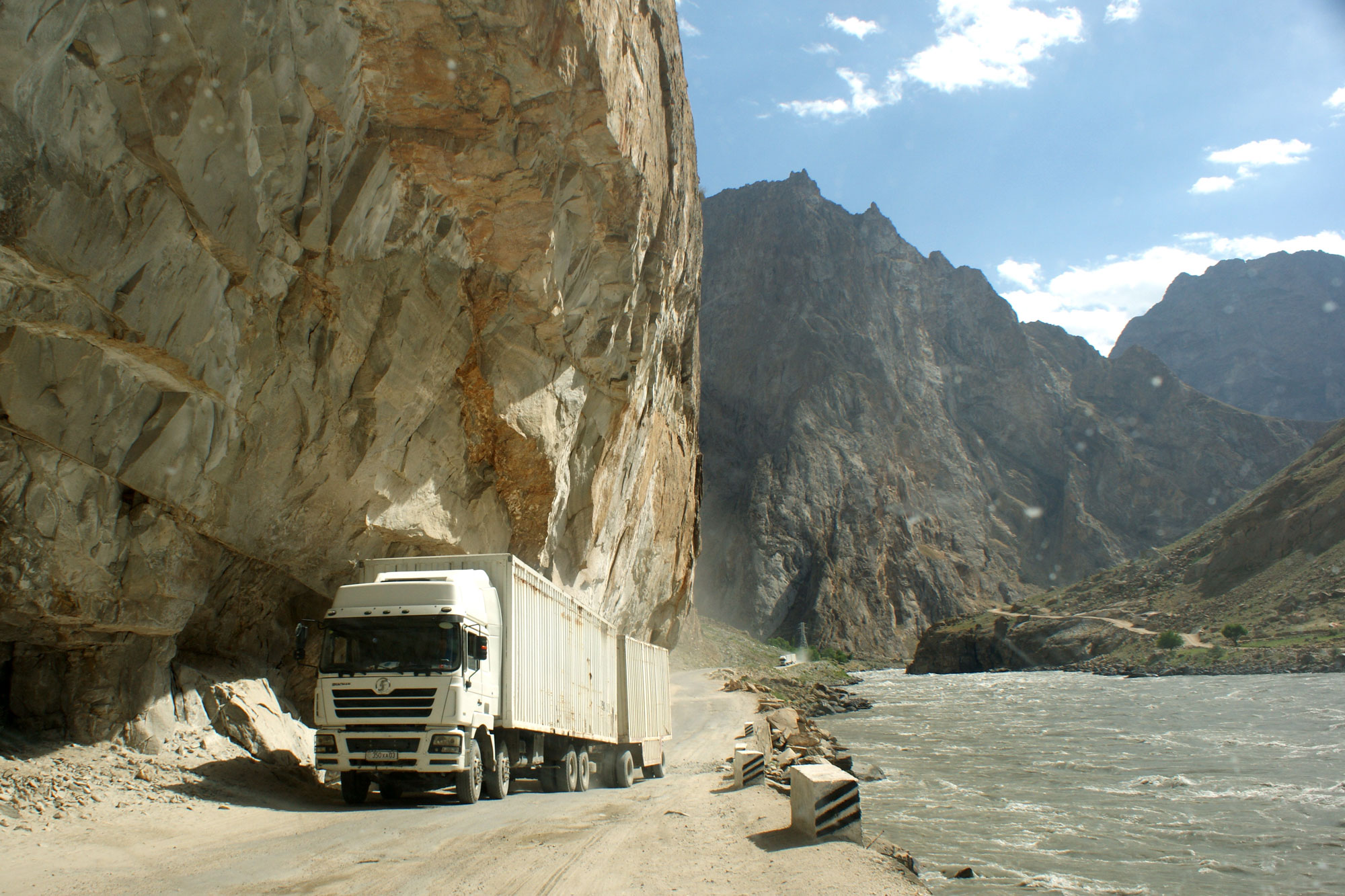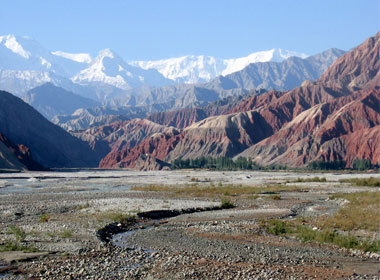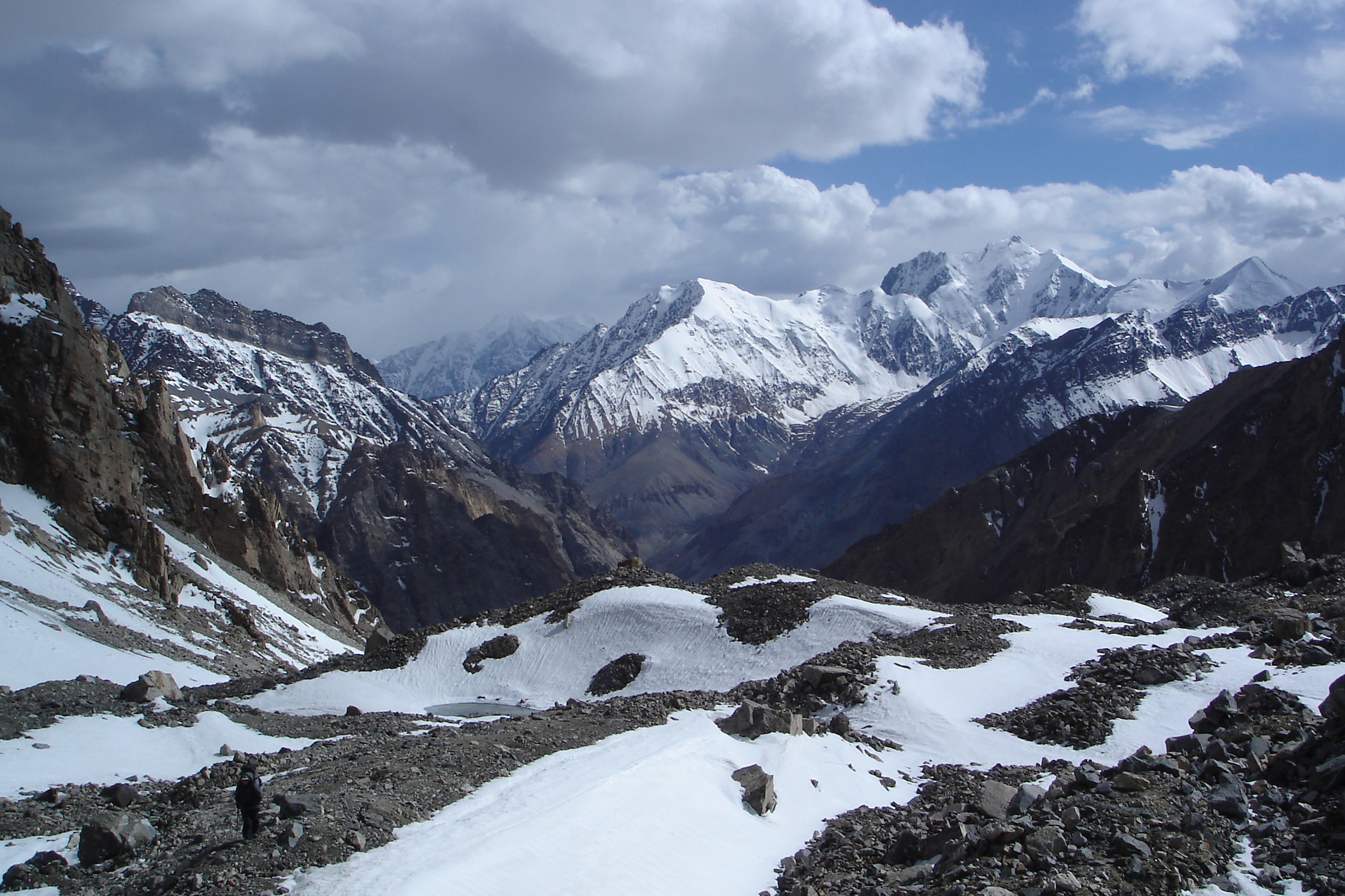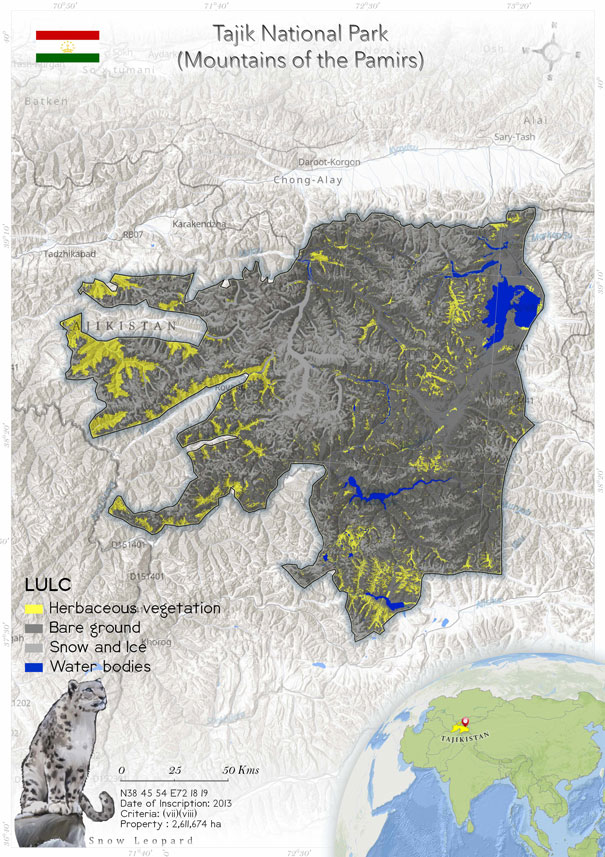
Tajik National Park (Mountains of the Pamirs)
 Tajik National Park is one of the most important protected areas of Tajikstan. Established in 1992, it attained its title as a World Heritage Site in 2013 due to the remarkable mountain ranges of the Pamir Mountains and its glaciers and rivers and rich biodiversity. However, the summers are very dry, due to which most of the area is arid and semi-arid in nature. All these factors gave rise to several types of vegetation with unique and endemic plants and animals. The vegetation mainly consists of desert and semi-desert vegetation, with shrubs. There are alpine trees in the mountain ranges. Near the rivers and lakes, there are meadows and wetlands as well as vast stretches of pastures. The faunal diversity is mainly represented by mammals. The most notable ones are the Marco Polo sheep, Siberian ibex and snow leopard. In the last few decades, the national park has experienced quite a number of threats to its biodiversity and natural landforms. Nomadic troops and indigenous people who established settlements at the foothills of the Pamir Range began indulging in agriculture, livestock grazing and extraction of natural resources, including hunting of the Marco Polo sheep and wild ungulates. This caused several changes in the ecosystem of the property and declines in the populations of the wild plants and animals. Many species were listed in the Red List as Endangered and Vulnerable. The State Party also began taking up conservation measures and instructed the management authorities to undertake patrolling and involve local people in protecting the heritage site.
Tajik National Park is one of the most important protected areas of Tajikstan. Established in 1992, it attained its title as a World Heritage Site in 2013 due to the remarkable mountain ranges of the Pamir Mountains and its glaciers and rivers and rich biodiversity. However, the summers are very dry, due to which most of the area is arid and semi-arid in nature. All these factors gave rise to several types of vegetation with unique and endemic plants and animals. The vegetation mainly consists of desert and semi-desert vegetation, with shrubs. There are alpine trees in the mountain ranges. Near the rivers and lakes, there are meadows and wetlands as well as vast stretches of pastures. The faunal diversity is mainly represented by mammals. The most notable ones are the Marco Polo sheep, Siberian ibex and snow leopard. In the last few decades, the national park has experienced quite a number of threats to its biodiversity and natural landforms. Nomadic troops and indigenous people who established settlements at the foothills of the Pamir Range began indulging in agriculture, livestock grazing and extraction of natural resources, including hunting of the Marco Polo sheep and wild ungulates. This caused several changes in the ecosystem of the property and declines in the populations of the wild plants and animals. Many species were listed in the Red List as Endangered and Vulnerable. The State Party also began taking up conservation measures and instructed the management authorities to undertake patrolling and involve local people in protecting the heritage site.
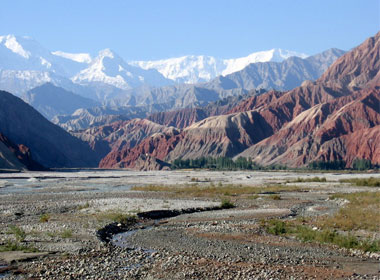 Caught in the Pamir Knot, of the infamous Pamir Mountains of Tajikistan, Tajik National Park spreads over 2.6 million ha (18% of the country's area) in the east. The Pamir Mountains are one of the highest ranges in Eurasia (World Heritage Datasheet 2011). The national park displays an extraordinary collection of elevations and geomorphology structures, particularly, glaciers (including Fedchenko Glacier, which is the longest glacier outside the polar region) and lakes and rivers such as Lake Sarez, Karakul Lake and the Amu Darya River. Being located at an altitude of 1500–1800 m above a 5000-m-high plateau, Tajik National Park is a massive property with glaciers in the east and the Pamir-Tien Shan Mountain Ranges in the west (UNESCO whc.unesco.org). With great seasonal variations, the temperature ranges between 10°C and 13°C in mid-summer and between -16°C and -25°C in mid-winter. Also, the region experiences huge tectonic forces deriving from the collision of the Indian-Australian Plate with the Eurasian Plate, which has progressively thrown up the Himalaya, the Karakoram Hindu Kush ranges, the Kunlun Mountains and Tien Shan—all radiating from the Pamir Mountains.
The biodiversity of Tajik National Park is greatly appreciated for its endemicity. Due to the extreme temperatures and low precipitation of the Pamir region, it is dominated by desert and semi-desert mountain vegetation. Several types of vegetation are found in the region, such as sub-alpine semi-desert, juniper, fir, broadleaf forests and tundra (Chemonics International Inc. report, 2001). In addition, the floral community of the whole massif of mountains is a mix of Siberian, Indo-Himalayan and Iranian elements.
The fauna displays high endemism. It is reported that the park is home to over 33 mammal species, 162 bird species, four fish species, three reptile species and one amphibian species with several subspecies. The most prominent and notable mammal is the snow leopard (Uncia uncia). The Marco Polo argali sheep (Ovis ammon polii) and Siberian ibex (Capra sibirica), tolai hare (Lepus tolai pamirensis), Tibetan wolf (Canis lupus laniger), fox (Vulpes vulpes ferganensis), Asiatic wild dog (Cuon alpinus), Himalayan brown bear (Ursus arctos isabellinus), alpine weasel (Mustela altaica), least weasel (Mustela nivalis pallida), stone marten (Martes foina intermedia), Asian badger (Meles leucurus), Eurasian otter (Lutra lutra), Turkestan lynx (Lynx lynx) and wild boar (Sus scrofa davidi). There are about five known species of rodent, namely, the Pamir vole (Microtus juldaschi), grey hamster (Cricetulus migratorius coereulescens), long-tailed marmot (Marmota caudata), big-eared pika (Ochotona macrotis) and silvery vole (Alticola argentatus) are other mammals. The avian community is also very fascinating as a total of 162 bird species have been recorded. These include the mountain goose (Anser anser), Himalayan griffon vulture (Gyps himalayensis), bearded vulture (Gypaetus barbatus), golden eagle (Aquila chrysaetos), Central Asian saker falcon (Falco cherrug coatsi) and Tibetan snow cock (Tetraogallus tibetanus). Pallas's sand grouse (Syrrhaptes tibetanus), the endemic Pamir sand plover (Charadrius mongolus pamirensis), the brown-headed gull (Larus brunnicephalus), the snow pigeon (Columba leuconota) and four endemic passerines also recorded within this WHS.
Caught in the Pamir Knot, of the infamous Pamir Mountains of Tajikistan, Tajik National Park spreads over 2.6 million ha (18% of the country's area) in the east. The Pamir Mountains are one of the highest ranges in Eurasia (World Heritage Datasheet 2011). The national park displays an extraordinary collection of elevations and geomorphology structures, particularly, glaciers (including Fedchenko Glacier, which is the longest glacier outside the polar region) and lakes and rivers such as Lake Sarez, Karakul Lake and the Amu Darya River. Being located at an altitude of 1500–1800 m above a 5000-m-high plateau, Tajik National Park is a massive property with glaciers in the east and the Pamir-Tien Shan Mountain Ranges in the west (UNESCO whc.unesco.org). With great seasonal variations, the temperature ranges between 10°C and 13°C in mid-summer and between -16°C and -25°C in mid-winter. Also, the region experiences huge tectonic forces deriving from the collision of the Indian-Australian Plate with the Eurasian Plate, which has progressively thrown up the Himalaya, the Karakoram Hindu Kush ranges, the Kunlun Mountains and Tien Shan—all radiating from the Pamir Mountains.
The biodiversity of Tajik National Park is greatly appreciated for its endemicity. Due to the extreme temperatures and low precipitation of the Pamir region, it is dominated by desert and semi-desert mountain vegetation. Several types of vegetation are found in the region, such as sub-alpine semi-desert, juniper, fir, broadleaf forests and tundra (Chemonics International Inc. report, 2001). In addition, the floral community of the whole massif of mountains is a mix of Siberian, Indo-Himalayan and Iranian elements.
The fauna displays high endemism. It is reported that the park is home to over 33 mammal species, 162 bird species, four fish species, three reptile species and one amphibian species with several subspecies. The most prominent and notable mammal is the snow leopard (Uncia uncia). The Marco Polo argali sheep (Ovis ammon polii) and Siberian ibex (Capra sibirica), tolai hare (Lepus tolai pamirensis), Tibetan wolf (Canis lupus laniger), fox (Vulpes vulpes ferganensis), Asiatic wild dog (Cuon alpinus), Himalayan brown bear (Ursus arctos isabellinus), alpine weasel (Mustela altaica), least weasel (Mustela nivalis pallida), stone marten (Martes foina intermedia), Asian badger (Meles leucurus), Eurasian otter (Lutra lutra), Turkestan lynx (Lynx lynx) and wild boar (Sus scrofa davidi). There are about five known species of rodent, namely, the Pamir vole (Microtus juldaschi), grey hamster (Cricetulus migratorius coereulescens), long-tailed marmot (Marmota caudata), big-eared pika (Ochotona macrotis) and silvery vole (Alticola argentatus) are other mammals. The avian community is also very fascinating as a total of 162 bird species have been recorded. These include the mountain goose (Anser anser), Himalayan griffon vulture (Gyps himalayensis), bearded vulture (Gypaetus barbatus), golden eagle (Aquila chrysaetos), Central Asian saker falcon (Falco cherrug coatsi) and Tibetan snow cock (Tetraogallus tibetanus). Pallas's sand grouse (Syrrhaptes tibetanus), the endemic Pamir sand plover (Charadrius mongolus pamirensis), the brown-headed gull (Larus brunnicephalus), the snow pigeon (Columba leuconota) and four endemic passerines also recorded within this WHS.
Criterion (vii)
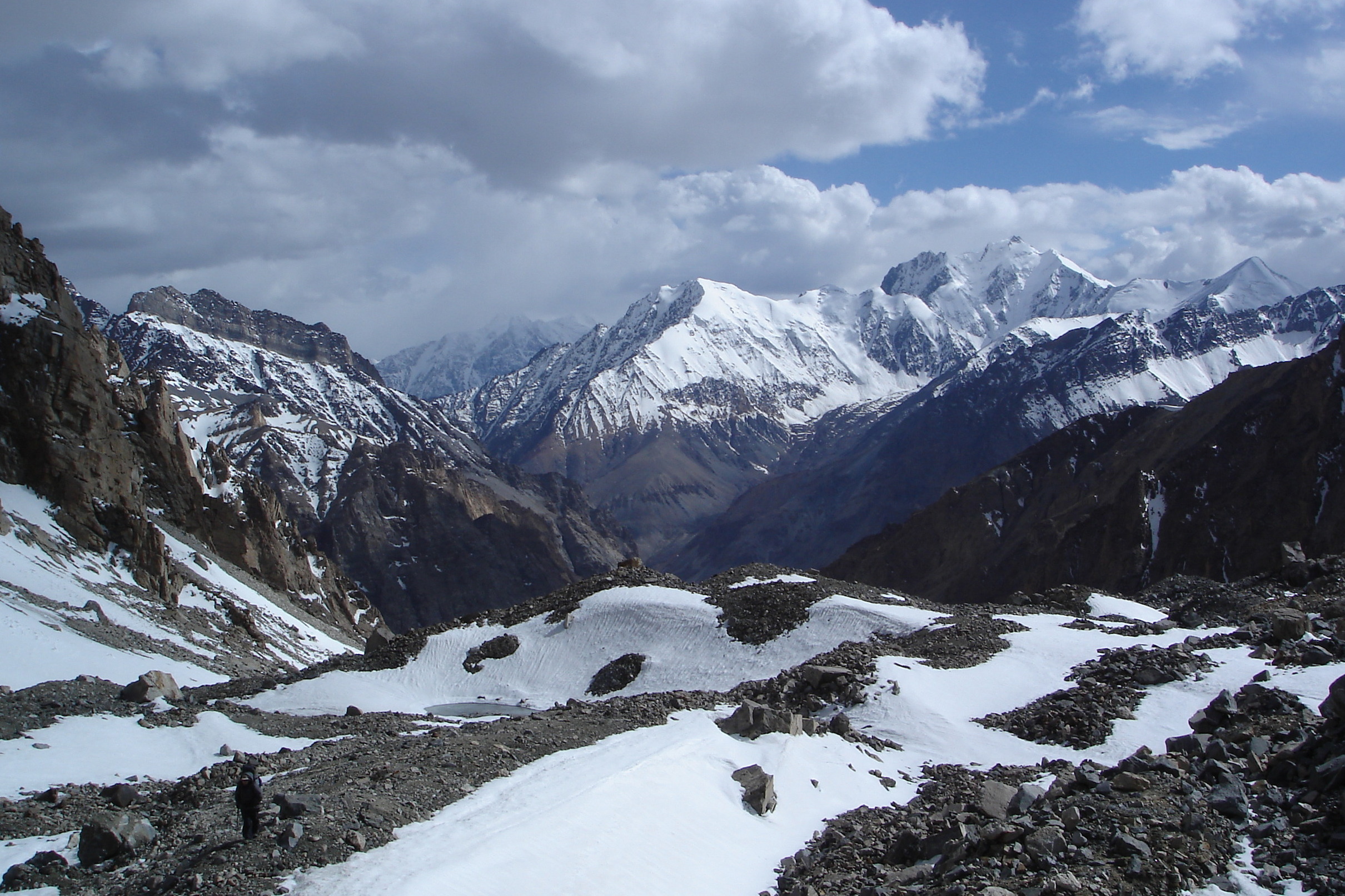 Tajik National Park is one of the largest high mountain protected areas in the Palearctic Realm. The Fedchenko Glacier, the largest valley glacier of the Eurasian Continent and the world's longest outside of the Polar Regions, is unique and a spectacular example at the global level. The visual combination of some of the deepest gorges in the world, surrounded by rugged glaciated peaks, as well as the alpine desert and lakes of the Pamir high plateaus adds up to an alpine wilderness of exceptional natural beauty. Lake Sarez and Lake Karakul are superlative natural phenomena. Lake Sarez, impounded behind the highest natural dam in the world, is of great geomorphic interest. Lake Karakul is likely to be the highest large lake of meteoric origin.
Tajik National Park is one of the largest high mountain protected areas in the Palearctic Realm. The Fedchenko Glacier, the largest valley glacier of the Eurasian Continent and the world's longest outside of the Polar Regions, is unique and a spectacular example at the global level. The visual combination of some of the deepest gorges in the world, surrounded by rugged glaciated peaks, as well as the alpine desert and lakes of the Pamir high plateaus adds up to an alpine wilderness of exceptional natural beauty. Lake Sarez and Lake Karakul are superlative natural phenomena. Lake Sarez, impounded behind the highest natural dam in the world, is of great geomorphic interest. Lake Karakul is likely to be the highest large lake of meteoric origin.
Criterion (viii)
The Pamir Mountains are a major centre of glaciation on the Eurasian continent and Tajik National Park illustrates within one protected area an outstanding juxtaposition of many high mountains, valley glaciers, and deep river gorges alongside the cold continental desert environment of the high Pamir Plateau landforms. An outstanding landform feature of the property's geologically dynamic terrain is Lake Sarez. It was created by an earthquake-generated landslide of an estimated six billion tones of material and is possibly the youngest deep water alpine lake in the world. It is of international scientific and geomorphological hazard significance because of the on-going geological processes influencing its stability, and the sort of lacustrine ecosystem which will develop over time. Tajik National Park furthermore offers a unique opportunity for the study of plate tectonics and continental subduction phenomena thereby contributing to our fundamental understanding of earth building processes.
Status
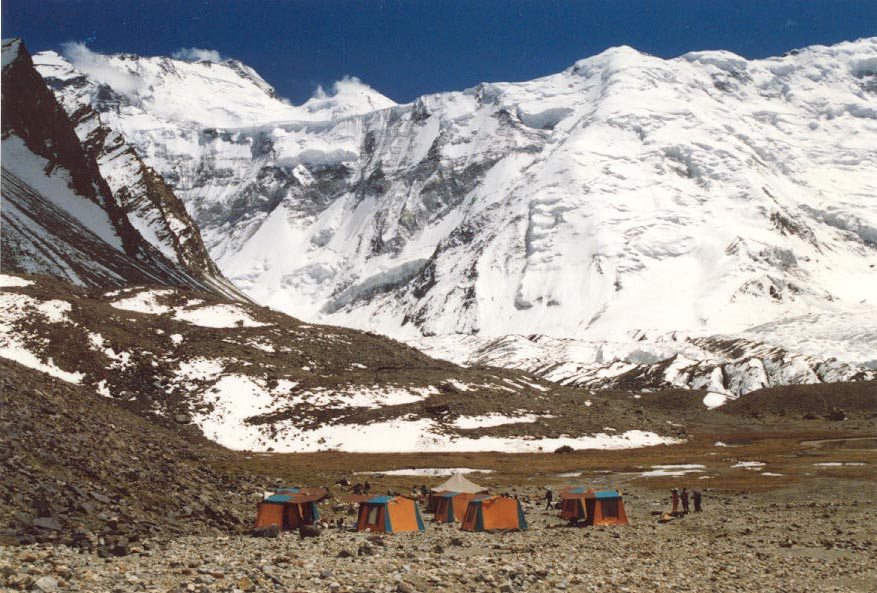 Before being inscribed as a World Heritage Site in 2013, Tajik National Park faced issues related to anthropogenic activities. Meadows and shrub habitats began to be occupied by nomadic troops for agriculture. They also began using these lands as pasture grounds for livestock grazing. Although the region's topographic and intense climatic conditions shield it from damaging external factors, human settlement began impacting the natural resources of the park. Grazing of livestock in the Tajik National Park also has adverse effects on the populations of wild ungulates. With rising numbers of domestic cattle in the pastures and open grasslands, the ungulates tend to shift to remote locations at higher altitudes that have less human interference. This affects their reproductive rates and the availability of feeding grounds. Moreover, due to a lack of proper fodder, the animals also change their spatial and social behaviour. They switch to nocturnal and start living in smaller groups. Such compelled habitat changes result in decreases in the population growth and in the physical condition of the animals (Boschi et al. 2008).
Hunting is yet another crucial factor that has been causing immense reductions in the populations of the endemic Marco Polo sheep, Siberian Ibex, snow leopard and Turkestan lynx. All these mammals are found in the Red List of the IUCN because their numbers have been depleted significantly by legal hunting. The indigenous people target the wild ungulates and Marco Polo sheep for meat, while the big cats are hunted by trophy hunters for pleasure (Shackleton/IUCN 1997). A current threat arose due to the construction of a small dam for storage of water in summer at an outlet of Lake Yashikul. It affected the aquatic biodiversity by causing the disappearance of four important species of fish, with one species being on the verge of disappearance (TNPb, 2012; IUCN Consultation 2020). The current management status seems to be working in favour of conservation of the vast resources and rich biodiversity of Tajik National Park. The development of ecotourism in such a region has contributed to the restoration of the ecological environment, the protection of the bio-system and the preservation of rare endangered animal species that are found in this region. The park is valued as a vital protected area, and people, both at national and international levels, are coming together to conserve its OUVs (Haslinger et al. 2007).
Before being inscribed as a World Heritage Site in 2013, Tajik National Park faced issues related to anthropogenic activities. Meadows and shrub habitats began to be occupied by nomadic troops for agriculture. They also began using these lands as pasture grounds for livestock grazing. Although the region's topographic and intense climatic conditions shield it from damaging external factors, human settlement began impacting the natural resources of the park. Grazing of livestock in the Tajik National Park also has adverse effects on the populations of wild ungulates. With rising numbers of domestic cattle in the pastures and open grasslands, the ungulates tend to shift to remote locations at higher altitudes that have less human interference. This affects their reproductive rates and the availability of feeding grounds. Moreover, due to a lack of proper fodder, the animals also change their spatial and social behaviour. They switch to nocturnal and start living in smaller groups. Such compelled habitat changes result in decreases in the population growth and in the physical condition of the animals (Boschi et al. 2008).
Hunting is yet another crucial factor that has been causing immense reductions in the populations of the endemic Marco Polo sheep, Siberian Ibex, snow leopard and Turkestan lynx. All these mammals are found in the Red List of the IUCN because their numbers have been depleted significantly by legal hunting. The indigenous people target the wild ungulates and Marco Polo sheep for meat, while the big cats are hunted by trophy hunters for pleasure (Shackleton/IUCN 1997). A current threat arose due to the construction of a small dam for storage of water in summer at an outlet of Lake Yashikul. It affected the aquatic biodiversity by causing the disappearance of four important species of fish, with one species being on the verge of disappearance (TNPb, 2012; IUCN Consultation 2020). The current management status seems to be working in favour of conservation of the vast resources and rich biodiversity of Tajik National Park. The development of ecotourism in such a region has contributed to the restoration of the ecological environment, the protection of the bio-system and the preservation of rare endangered animal species that are found in this region. The park is valued as a vital protected area, and people, both at national and international levels, are coming together to conserve its OUVs (Haslinger et al. 2007).
